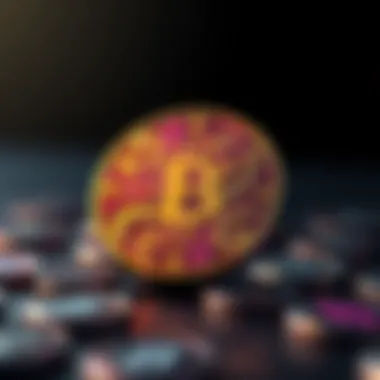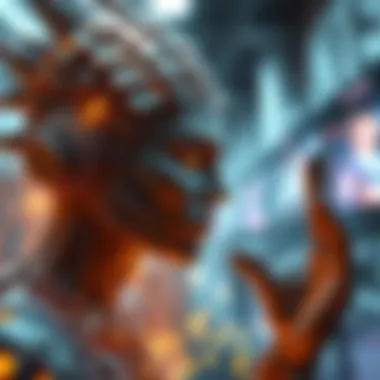Exploring the Intricacies of Cool NFTs Today


Intro
The landscape of digital assets has transformed dramatically in recent years, and at the forefront of this change are non-fungible tokens, commonly known as NFTs. Unlike traditional currencies such as Bitcoin or Ethereum, which are interchangeable, NFTs are unique and cannot be exchanged on a one-to-one basis. This uniqueness is what makes them particularly intriguing, capturing the attention of artists, collectors, and investors alike. Understanding what differentiates a "cool" NFT from the countless others on the market involves looking into various facets—artistic value, technological innovation, and market dynamics.
With NFTs expanding their reach beyond digital art into realms like gaming and music, grasping the intricacies at play is essential. This section aims to set the stage for an in-depth exploration of this vibrant ecosystem, making it easier for both newcomers and seasoned players to navigate the complex waters of NFTs.
\n
Understanding the NFT Phenomenon
What are NFTs?
NFTs are a type of digital certificate that prove ownership of a unique item or piece of content, often created and stored on a blockchain. Each NFT carries metadata and a unique identifier, ensuring that no two tokens are alike. This opens up a world of possibilities, as NFTs can represent a wide array of items from digital art to tweets, music albums, and even virtual real estate.
In essence, NFTs serve as digital collectibles, allowing creators to monetize their work and giving buyers a sense of ownership. The rise of NFTs doesn't just hinge on art; they encapsulate a broader shift in how we view ownership and value in the digital realm.
Unique Traits of "Cool" NFTs
When discerning what makes an NFT cool, several characteristics stand out:
- Artistic Innovation: Aesthetics and creativity play a significant role. An NFT that pushes boundaries in terms of design, interactivity, or concept often garners more attention.
- Provenance: Who created it? The artist's reputation and the NFT's backstory can enhance its desirability.
- Rarity: Limited editions or unique pieces tend to captivate collectors. The scarcity principle often drives higher demand.
- Community Engagement: Some NFTs come with perks, like membership in exclusive clubs or access to future content, fostering a loyal following.
\n
"The NFT space is not only about ownership; it's about participating in a community that values uniqueness and creativity."
Implications Across Industries
The ripple effects of NFTs extend far beyond digital art. They can revolutionize how music artists distribute their work, offering them more control and a larger slice of the revenue pie. In gaming, NFTs enable players to truly own their in-game assets, potentially reshaping the economy of virtual worlds.
As the industry continues to evolve, it begs the question: How will NFTs reshape traditional concepts of ownership? Understanding these implications is crucial for anyone looking to invest or create in this burgeoning field.
Intro to NFTs
The digital landscape is changing at a rapid pace, and non-fungible tokens (NFTs) stand at the forefront of this evolution. Understanding NFTs is crucial for anyone engaging with the modern economy, particularly for investors, artists, and tech enthusiasts. They're not just digital collectibles; they signal a shift in how we understand ownership, creativity, and value in the digital realm. This section will clarify what makes NFTs significant and why their study is paramount for both novices and seasoned professionals.
The Definition of Non-Fungible Tokens
When we peel back the layers surrounding NFTs, we find that they are essentially unique digital assets stored on a blockchain. Unlike cryptocurrencies such as Bitcoin or Ethereum, which are fungible and can be exchanged on a one-for-one basis, NFTs have distinct qualities. Each NFT is one-of-a-kind, which means they cannot be swapped or replicated like their fungible counterparts. This uniqueness grants them value in ways that traditional assets may not possess.
For instance, NFTs can represent a wide array of digital creations — art, music, virtual real estate, and even tweets. They provide artists with new revenue streams and empower them to maintain control over their works. By embedding metadata directly into the token, artists can define ownership and provenance.
Such specificity has multiple implications. Customers not only purchase a piece of an artist's work but grab a slice of their identity, adding depth to their digital experience.
Historical Context of Digital Ownership
To appreciate where NFTs fit today, understanding the evolution of digital ownership is vital. The concept isn't entirely novel; digital files have circulated freely on the internet for years. However, prior to the emergence of NFTs, the notion of owning a digital piece, similar to physical items, was largely abstract. Artists struggled to monetize their works, and collectors found it challenging to prove ownership.
This gap led to a burgeoning grey market where digital goods could be copied and distributed willy-nilly, often without compensating the original creator. Enter blockchain technology. By leveraging this decentralized ledger, NFTs allow owners to validate authenticity and ownership, ushering in a new paradigm in digital rights management. The impact on various industries—especially art, gaming, and music—cannot be understated.
"As we navigate this evolving digital landscape, understanding the roots of ownership will shape how we interact with NFTs moving forward."
Characteristics of Cool NFTs
The phrase "cool NFTs" might seem a bit subjective at first glance, yet there exists a distinctive set of characteristics that can elevate some tokens above the rest. In this examination, we’ll unpack what exactly makes certain NFTs particularly appealing and how their unique traits play a pivotal role in shaping desire among collectors and investors alike. Understanding these characteristics isn't just for the digital art aficionado or tech boffin – it’s crucial for anyone looking to navigate this evolving landscape.
Rarity and Uniqueness


One of the crowning features of a cool NFT lies in its rarity and uniqueness. In the world of NFTs, the term "non-fungible" is key. Unlike a dollar bill that can be swapped for another exact bill, each NFT holds distinct information and characteristics on the blockchain. This lends itself to a limited supply aspect, much like rare coins or stamps.
- Limited Editions: Many successful NFTs are created in limited runs, adding to their allure. For instance, consider the artist Pak, whose works often come with strict limitations on the number of pieces created, making them highly sought after by collectors.
- Unique Metadata: Each NFT is encoded with metadata that can include anything from an artist’s backstory to the story behind the creation itself. For example, the infamous "Crossroads" NFT by Beeple wasn’t just a digital image; it held a narrative that spoke volumes about contemporary societal issues.
When a collector comes across an NFT with a small number of copies, it’s not just a piece of art; it’s an investment in scarcity, which brings a certain prestige along with it.
Artistic Expression and Innovation
Art transcends boundaries, and NFTs have taken that a step further by putting a spotlight on innovation and creative expression. Historically, physical artwork is usually beholden to genres or movements. However, NFTs break those shackles, allowing artists to explore new terrains.
- New Mediums: Digital artists can use cutting-edge technology such as augmented reality, virtual reality, or interactive pieces to create NFTs that leave the viewer not just looking, but engaging. This expands the very concept of art into territories previously reserved for performance or participatory art.
- Cross-Platform Collaborations: Artists are no longer creating in silos. Collaborations happen across different platforms and even across different artistic disciplines. Think of the convergence of music and visual art, like the recent NFT drops that uniquely marry audio tracks with visual designs, showcasing a holistic artistic experience.
The innovative attribute of cool NFTs lies not just in their visual appeal but in how they push the boundaries of what digital art can become.
Community Engagement and Interactivity
Cool NFTs are not just solitary pieces hanging in a gallery; they invite interaction and foster community engagement. This characteristic is increasingly important in an era where audiences crave connection and involvement.
- Token-Gated Communities: Ownership of a specific NFT can grant access to exclusive online or offline communities. For example, owning a Bored Ape Yacht Club NFT provides entry to gatherings and events tailored for the club’s members, creating a culture built around shared ownership.
- Interactivity: Some NFTs provide interactive features, allowing users to engage with the piece itself. An example is the game “Axie Infinity,” where users can breed, raise, and battle their NFTs known as Axies. This gaming element transforms the NFT into a living ecosystem rather than a static item.
Engagement goes beyond ownership; it fosters a sense of belonging and shared experience that's invaluable in today's digital landscape.
Ultimately, the characteristics of rarity, artistic innovation, and community engagement create a compelling narrative that attracts collectors and enthusiasts to the world of NFTs. Understanding these elements can not only enhance appreciation for these digital assets but also inform investment strategies within this rapidly evolving market.
Technological Underpinnings of NFTs
Understanding the technological underpinnings of NFTs is crucial for grasping their current and future impact in the digital marketplace. At the heart of NFTs lies blockchain technology, which provides a secure, transparent, and immutable way to prove ownership of digital assets. This section will unravel the complexities of blockchain, explore smart contracts, discuss the significance of decentralization, and touch on the concept of interoperability across various platforms.
Blockchain Technology Basics
Blockchain technology is like a digital ledger that records transactions across multiple computers. This decentralization means that nobody has total control over all the data, which adds a level of security and trust that’s hard to hack or manipulate.
Smart Contracts
Smart contracts are self-executing contracts where the terms are directly written into code. They automatically enforce and execute the terms when certain conditions are met. This characteristic makes them a backbone of NFT transactions. Not only do they eliminate the need for intermediaries, which can save time and money, but they also reduce the risk for all parties involved.
One of the unique features of smart contracts is their programmability. Artists and creators can set specific conditions around their work. For example, an artist might create a contract that ensures they receive a percentage of sales every time their NFT changes hands.
However, there are considerations to keep in mind. Coders must be precise because mistakes in the contract code can lead to unintended outcomes. This complexity can be a double-edged sword, as it enhances functionality but requires careful management.
Decentralization
Decentralization is a key concept in the world of NFTs. Unlike traditional ownership models, which concentrate control in the hands of a few, decentralization spreads out authority across a network. This method is fundamental in maintaining the integrity and transparency of the NFT system. It enables users to engage with the platform without fear that someone will alter the rules on a whim.
One major advantage of decentralization is that it increases trust among users. Since there is no central authority that can manipulate the system, people feel more secure buying or selling NFTs. However, this feature also comes with challenges. Because control is dispersed, if problems arise, pinpointing accountability can become tricky. Developers must build systems that not only offer benefits but also address these potential pitfalls.
Interoperability Across Platforms
Interoperability refers to the ability of different systems to work together seamlessly. In the NFT ecosystem, this is particularly important as it paves the way for NFTs to be bought and sold across multiple marketplaces. A token created on one platform should ideally be able to function on another without any hiccups.
This interconnectedness stands to elevate the entire NFT landscape. Artists can reach broader audiences, and collectors can move their assets freely between platforms without losing value. However, achieving full interoperability remains a work in progress, influenced by varying standards and regulations across the industry.
Popular NFT Marketplaces
In the bustling realm of non-fungible tokens, finding the right place to buy, sell, or trade your digital assets is pivotal. These marketplaces are not just mere storefronts; they're vibrant ecosystems where creators and collectors converge. Each platform comes packed with its unique characteristics, benefits, and challenges, which can greatly influence user experience and investment strategies. As NFTs continue to evolve, understanding these marketplaces enables buyers and sellers to navigate the landscape more effectively, making well-informed decisions that can lead to profitable opportunities.
Overview of Leading Platforms
OpenSea


Let's start with OpenSea, a stalwart in the NFT marketplace world. This platform is often dubbed the Amazon of NFTs, owing to its extensive range of digital collectibles. One significant aspect of OpenSea is its user-friendly interface, allowing even the most technologically challenged folks to register and list their assets without breaking a sweat. What sets OpenSea apart is its sheer scale—it offers millions of NFTs spanning various categories, from art to virtual real estate.
A key characteristic enticing users is OpenSea’s support for multiple blockchains, primarily Ethereum but also extending to Polygon and Klaytn. This multi-chain approach is a boon for creators and collectors alike. It gives flexibility when it comes to blockchain fees and environmental concerns, as users can choose their preferred network.
- Unique Feature: OpenSea implements an open market framework, which facilitates the buying and selling of NFTs in a decentralized fashion.
- Advantages: This inclusivity fosters a diverse mix of creators and collectors, encouraging the emergence of unique artworks and themes.
- Disadvantages: However, the vastness of offerings can sometimes lead to information overload for new users, making it challenging to discern quality from quantity.
Rarible
Next, we have Rarible, which takes a participatory approach to the NFT space. This platform empowers users to create and issue their own tokens, thereby engaging them directly in the ecosystem. Rarible’s distinguishing feature is its emphasis on community governance; it operates on a DAO (Decentralized Autonomous Organization) model where RARI token holders have a say in platform development.
The platform stands out because it allows users not just to buy and sell but to play an active role in shaping the marketplace’s future. This element of user involvement is why Rarible finds favor among developers and creators looking to establish a connection with their audience beyond the transaction.
- Unique Feature: The community-driven approach means that users can earn rewards for participating in governance, allowing for a stake in the marketplace.
- Advantages: This participatory ethos can drive innovation and create unique opportunities for collaboration, distinguishing Rarible from more traditional platforms.
- Disadvantages: On the flip side, the model may introduce complexities for individuals who are less tech-savvy or who prefer a simpler buying experience.
Understanding Fees and Transactions
When venturing into the world of NFTs, it’s crucial to grasp how fees and transactions operate within these marketplaces. Platforms typically charge transaction fees on sales, which can range anywhere from a modest percentage to somewhat hefty cuts. These fees often cover the costs associated with blockchain transactions and platform maintenance.
- Types of Fees:
- Transaction Dynamics: Each transaction involves sending cryptocurrencies, usually requiring an understanding of gas fees, which vary based on network congestion.
- User Considerations: Always keep in mind the cost of entering the marketplace and selling your digital assets. Assess the platforms’ fee structures to avoid unexpected costs that could eat into your profits.
- Minting Fees: Costs incurred when creating a new NFT.
- Listing Fees: Some platforms may charge to list your NFT for sale.
- Transaction Fees: A percentage deducted from sales.
Understanding these elements will help investors make strategic choices, directly impacting their overall experience in the NFT market.
Market Dynamics and Trends
Understanding market dynamics and trends in the NFT landscape is like having a map in uncharted waters. The NFT market is not just a collection of whimsical images and tokens; it's a complex ecosystem influenced by various factors. As more artists, developers, and investors engage with this digital frontier, the importance of grasping what drives values and trends becomes paramount.
Value Assessment of NFTs
Value assessment of NFTs poses a multifaceted challenge, one that intertwines aspects of art valuation, market behavior, and consumer psychology. Unlike physical artworks, where scarcity is often obvious, NFTs complicate the notion of value. Their worth is shaped not only by aesthetics but also by the reputation of the creator, rarity, and, importantly, the community sentiments surrounding them.
When assessing the value of a specific NFT, consider these essential elements:
- Creator Repute: NFTs from recognized or emerging artists can command higher prices.
- Rarity: Limited editions or one-off releases typically boost perceived value. A lonely pixelated creature might fetch a small fortune, while a mass-produced visual could barely make a splash.
- Market Trends: What’s hot today might be yesterday’s news tomorrow. Stay abreast of seasonal trends that influence demand.
- Utility: Some NFTs offer more than mere ownership; they may provide access to exclusive events or additional content. This added value can make them more desirable.
In the end, understanding the nuances of value assessment can make all the difference between snatching up a gem or investing in a dud.
The Role of Speculation in NFT Pricing
The role of speculation in NFT pricing often feels like a double-edged sword. Speculative investments can drive prices into the stratosphere; yet, they can just as easily plunge when the market cools.
Speculation shapes NFT pricing in these ways:
- Hype and Buzz: Social media can ignite fervor, leading to quick turns in value based on nothing more than whispers and trends.
- Influencer Endorsements: A shout-out from a popular figure can catapult an NFT into the limelight, drawing in collectors eager to ride the coattails of fame.
- Market Psychology: The "fear of missing out" can push buyers to act fast, sometimes inflating prices beyond reasonable evaluations.
- History of Past Sales: Prices from previous transactions often set a precedent, creating an environment where future buyers assume prices will only rise.
"The NFT market is much like a house of cards; while you might feel on top of the world with a significant investment, a single breeze could come along and change the entire landscape."
In summary, speculation breathes life into the aesthetics of NFT pricing but also introduces risk. Investors must navigate these waters with caution. One moment's glimmering excitement can vaporize, leaving those entranced without double-checking the foundations supporting their investments.
NFTs in Various Industries
NFTs have increasingly woven themselves into the fabric of various industries, making their mark far beyond just digital art. This section will delve into the significance of NFTs in fields like art, gaming, and music, highlighting how they reshape traditional frameworks of ownership and creativity, while also addressing some considerations entailed with their integration.
The Impact on Digital Art
Digital art has, for decades, faced challenges around ownership and intellectual property. With the rise of NFTs, artists now have a revolutionary way to signify ownership and authenticity of their work. No longer is it just about having a JPEG file on your computer, but, rather, owning a verifiable token on the blockchain that proves your claim.


"The latest wave of digital artworks presented as NFTs has shifted the art world dynamic, allowing creators to retain a share of their work's future sales through royalties."
NFTs have empowered artists like Beeple, who sold a digital collage for an astounding $69 million, capturing the attention of collectors and investors alike. This sale painted a new landscape, where creatives can monetize their work without relying on traditional galleries or intermediaries. Moreover, this allows artists to create editions of their work, making rarity a driving factor in value, alongside artistic quality. The combination of uniqueness and verifiable ownership can foster exponential growth within the digital art sector.
Gaming and NFTs
In the gaming world, NFTs provide a groundbreaking approach to ownership. Players can buy, sell, and trade in-game assets as tokenized items. This means that once you purchase a sword or a skin in a game, it’s truly yours—not just a line in a database. In games such as Axie Infinity, players can generate income through NFTs by breeding, trading, or battling unique creatures.
Besides creating an economy around gaming assets, NFTs introduce interoperability between games. Imagine utilizing a character in one game who leaps into another world, decked out with tokens you've earned elsewhere. This potential shifts the power dynamics in gaming, giving players a stake in their virtual environments. However, there’s an underlying concern about balance: as the lines blur between play and profit, ethical considerations arise regarding player engagement and game design.
Music and Ownership Rights
Traditionally, distributing music has granted control heavily to record labels and intermediaries. NFTs offer artists a new frontier where they can directly sell their music and lore to fans, retaining more earnings related to their creations. The likes of musicians such as Grimes have already experimented with NFTs, selling unique tracks tied to exclusive ownership rights.
This efficiency could create a more equitable landscape for artists, giving them direct interaction with their audiences and fostering tighter community bonds. It'll also prompt a reevaluation of music rights, enabling artists to set terms for how their music is used, from NFTs affording access to live streams to concert tickets. However, as these changes unfold, discussions about copyright and distribution must surface to minimize complications between artists and rights holders.
Future Directions for NFTs
The future of non-fungible tokens (NFTs) is a critical discussion point in understanding this evolving digital landscape. As NFTs have gained traction, the contours of their acceptance and integration into daily life continue to shift. It's not merely about how they function now but also about how they will fit into future contexts. Regulatory landscapes and technological advancements will shape the framework in which NFTs operate, potentially leading to broader acceptance and more innovative applications.
Potential Regulatory Changes
With the meteoric rise of NFTs, regulators around the globe are starting to pay closer attention. The potential for regulation is not just a looming shadow, but a necessary evolution to enhance the credibility of the NFT market. Here are some key points to consider:
- Consumer Protection: Regulations may aim to protect buyers from fraud, ensuring that what they purchase is authentic and not merely an illusion.
- Tax Guidelines: How NFTs are taxed is still murky. Clear guidelines from tax authorities could make investments more appealing and straightforward for buyers and sellers alike.
- Intellectual Property Rights: Potential regulations may help clarify ownership rights and what constitutes fair use, allowing creators and buyers to navigate the landscape without fear.
The key challenge lies in balancing innovation with safety. Too much regulation could stifle creativity, but a total lack of oversight can lead to chaos. Thus, a synergetic approach may be the best course that preserves the spirit of NFTs while also safeguarding stakeholders.
Technological Innovations on the Horizon
As NFTs continue to captivate the imagination of technologists and artists, cutting-edge advancements offer exciting prospects. Looking ahead, here are several innovations poised to reshape the NFT ecosystem:
- Layer 2 Solutions: These will aim to enhance transaction speed and reduce costs associated with blockchain transactions. This could make NFTs even more accessible, fostering wider adoption.
- Cross-chain Compatibility: The ability for NFTs to exist on multiple blockchains holds immense potential. It could enable seamless transactions across different ecosystems, further enriching user experience.
- Enhanced Interactivity: As technology evolves, so too could the nature of NFTs. Imagine NFTs that respond to external data or provide interactive experiences. This could be a game changer in industries like gaming and event promotions.
"In the rapidly changing world of digital ownership, foresight is just as important as creativity."
For more information on NFTs and their implications, you can refer to sources such as Wikipedia or explore ongoing discussions on platforms like Reddit.
As the NFT ecosystem continues to evolve, keeping an eye on the latest trends and potential changes will help investors, traders, and creators navigate this dynamic environment.
Finale
As we reach the end of our exploration into the multifaceted world of non-fungible tokens, it's essential to reflect on the significance of these digital assets. The evolution of NFTs demonstrates how they have transformed from obscure digital commodities to pivotal elements in various sectors. This shift hints at a promising horizon for both creators and investors, suggesting that we are only scratching the surface of what is possible. The unique characteristics that make certain NFTs stand out have solidified their place in contemporary culture and commerce.
The Evolution of NFTs
The journey of NFTs is akin to a tapestry being woven from disparate threads, each symbolizing cultural, technological, and economic influences. Initially, many folks viewed NFTs as quirky digital images or, simply put, a fad. However, with significant players entering the market and enhancing their utility, they have embarked on a more profound trajectory. Think about projects like CryptoPunks or Bored Ape Yacht Club – they opened the floodgates for mainstream media attention and buyer interest.
Early adopters foresaw potential long before the term 'NFT' became a buzzword. Platforms like Ethereum set the groundwork by enabling the creation of smart contracts that could execute transactions autonomously, laying the path for various applications across industries. As the blockchain ecosystem grew, so too did the number of creators seeking to monetize their work through this means. Artists previously relegated to traditional methods now find new audiences and revenue streams thanks to NFTs. Over time, their functionality has broadened, paving the way for elements like virtual real estate and tokenized ownership in various assets.
The Role of Cool NFTs Going Forward
Looking ahead, the role of NFTs that resonate as 'cool' is set to expand beyond art and collectibles. As developers and brands continue to innovate, aspects such as interoperability and enhanced community engagement are likely to shape their future. For example, gaming might see player avatars or in-game assets transferred across multiple platforms, rooted in a chain of ownership that adds value to the player's experience.
Moreover, the combination of augmented reality and NFTs might bring to life experiences that were once confined to our imagination. Can you picture wearing digital art as a fashion statement? It may sound outlandish now, but in just a few years, these concepts could materialize into game-changers.
In this evolving landscape, considerations around copyright, artist royalties, and environmental impact will likely spark discussions that necessitate careful thought and proactive solutions. Engaging with these elements could determine both the short-term viability and long-term sustainability of NFTs.
"The future isn’t something you enter, the future is something you create." — Leonard I. Sweet
Overall, understanding the trajectory of NFTs will arm investors, creators, and tech enthusiasts with the insights needed to navigate what's ahead. Will NFTs grow in prominence or dwindle into obscurity? The answer lies not just in the technologies but in the minds of the innovators daring to push boundaries beyond the status quo.



